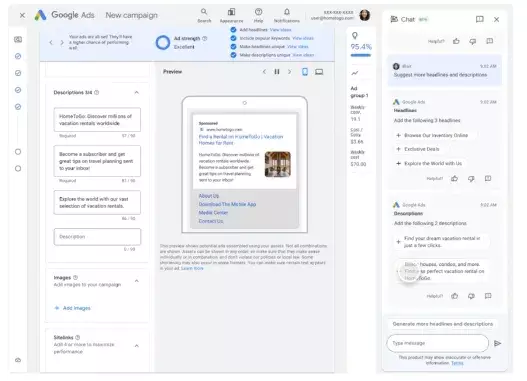At the forefront of digital marketing innovation, Google continually seeks to enhance its advertising suite through artificial intelligence (AI). Recently unveiled at the prestigious DMEXCO conference, Google’s latest advancements to Google Ads aim to streamline the advertising process and augment performance through AI-driven functionalities. While the sheer volume of AI features may initially overwhelm, a closer examination reveals a coherent strategy aimed at empowering advertisers across multiple domains.
A noteworthy element of Google’s recent announcement is the expansion of its AI-driven ad creation tools into additional languages. Initially exclusive to English-speaking users, the “conversational experience for Search campaigns” will soon cater to German, French, and Spanish speakers. By reducing language barriers, Google is not only broadening its user base but also enabling advertisers from various linguistic backgrounds to leverage AI effectively. The process is straightforward: advertisers can enter their landing page URL and allow Google’s AI to generate a comprehensive array of promotional attributes, including descriptions, keywords, and images. This simplification could lead to increased participation from smaller businesses that might previously have lacked the resources to engage in effective advertising.
In addition to language support, Google is significantly enhancing its AI image editing capabilities. Previously available only for Performance Max campaigns, these advanced tools will now extend to Search, Demand Gen, App, and Display campaigns. This expansion signifies Google’s recognition of the increasing importance of visual content in advertising and the need for advertisers to adapt quickly to ever-changing market dynamics. By integrating these advanced customization tools, advertisers will have an unprecedented level of control over their visual assets, which could lead to more engaging and appealing ad campaigns.
Perhaps one of the most exciting updates involves Google’s new visual asset generation tools, which will accommodate multiple languages and allow users to submit reference images. By enabling advertisers to provide up to five reference images along with prompts, Google is fostering a creative space where brands can tailor their images more closely to their vision. Concurrently, Google’s expansion of brand guidelines for Performance Max campaigns grants advertisers even more control over AI-generated assets. This dual approach not only enhances creativity but also aligns closely with brand identity, ensuring that the generated content resonates with target audiences.
Accompanying the new image and asset generation capabilities are significant improvements in reporting and analytics. Google’s introduction of asset coverage reporting in Performance Max campaigns empowers advertisers to identify underperforming asset groups and receive actionable recommendations. This data-driven approach enables marketers to make informed decisions, adjusting their strategies to meet specific advertising goals. By focusing on measurable outcomes, Google underscores the growing significance of AI as a tool for optimizing ad performance rather than merely a novelty.
While AI image-generation tools may sometimes yield mixed results, Google’s enhancements highlight a critical application of generative AI—transforming the advertising landscape. Unlike tools that merely provide entertainment, these advancements have a clear and tangible benefit for brands. By leveraging past performance data and user input, Google is positioning its AI capabilities not merely as an experiment but as an indispensable asset for advertisers who desire a competitive edge.
Google’s unveiling of a myriad of AI advancements underscores its commitment to revolutionizing online advertising. By democratizing the advertising process, enhancing creative control, and focusing on data-driven performance insights, Google is presenting a robust framework for advertisers to thrive. As businesses navigate this AI-enabled landscape, those willing to embrace these tools will likely find themselves equipped to create compelling, effective campaigns that engage audiences and drive results. Through continuous innovation, Google is not just responding to the changing landscape of advertising; it is actively shaping its future.


Leave a Reply